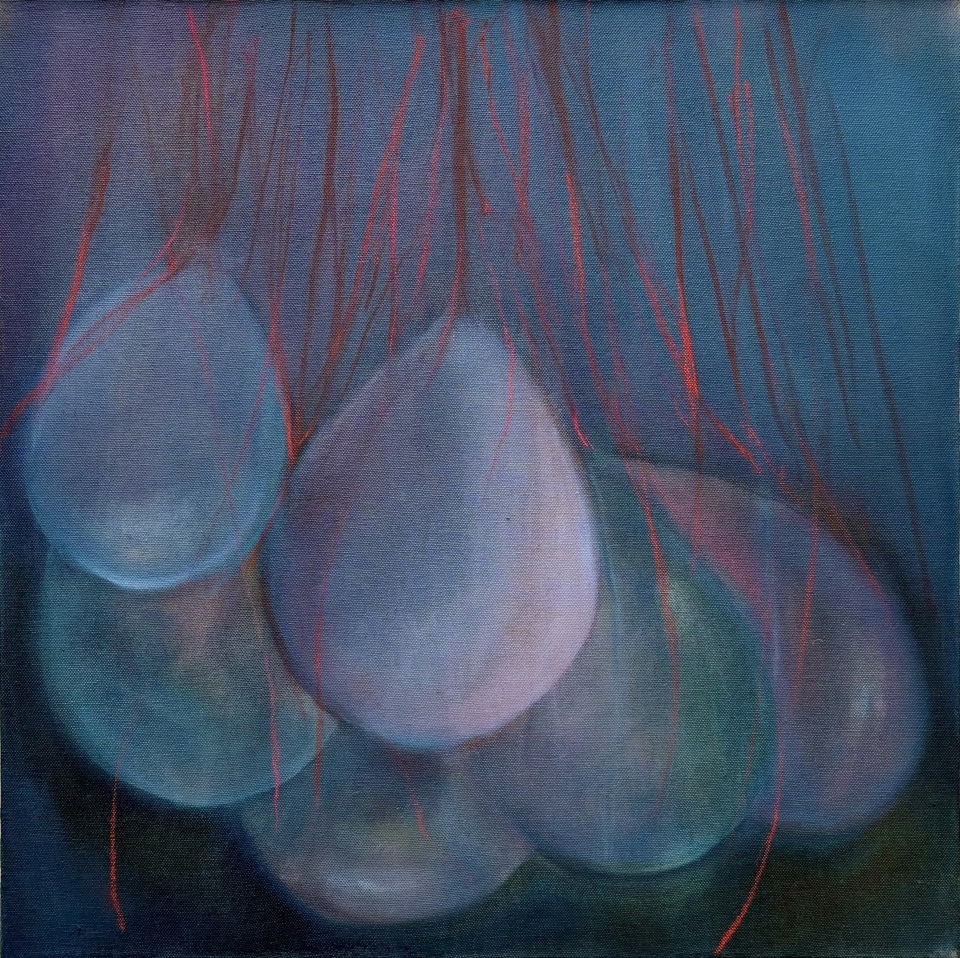“The relation between what we see and what we know is never settled.”
John Berger, Ways of Seeing
Alma Mater
Mothers are universal. In each culture they raise and nourish the young and care for the sick and old. The allegorical Latin term Alma Mater was used in ancient Rome, referencing their goddesses and literally meaning ‘nourishing or bountiful mother.’ There are many ways how to say mother: ‘Mutter, Mama, Maman, Mom, Moeder, Ommi, Walida and so on.’
Nadja Stamselberg, unexpectedly lost her cherished mother in 2021. The sudden shock and the pain of this heartbreaking event encouraged her to engage in an MA programme in painting with the Royal College of Art, London. The exhibition 'Alma Mater’ where we encounter Stamselberg's otherworldly paintings are the result of such a life changing happening and decision.
Navels, balloons, inflatables, membranes, breasts, knots and strings painted in trompe l’oeil effect seize our gaze. At first glance these translucent balloons with their whitish and orange-coloured strings have a playful quality but emanate a strange sensation.
What do viewers make of Stamselberg's coloured membranes? Do these representations emphasis her close relationship with her mother, like spiders who were a metaphor for Louise Bourgeois’ departed mother. In 1995, Bourgeois said: "My best friend was my mother, she was deliberate, clever, patient, soothing, reasonable, dainty, subtle, indispensable, neat, and as useful as an araignée".
In the major exhibition area, we encounter a display of numerous square and rectangular canvases depicting single and several gliding inflatables. Ambiguity and fragility are the first impression of these alien cocoons.
‘Breath In’ takes centre stage, an embryonic prenatal loop that brings to mind the growth and development of a fetus in a womb, wrapped with a precariously flowing orange birth cord. Next to it on the right we come across the painting ‘Hang in There,’ where a group of light blue balloons seemingly out of nowhere hover on their ginger strings. Stamselberg breathes life and depth into these mysterious forms by utilising different hues, which signifies their ripened state, ready to burst. Further along, there is ‘Mama’ a canvas portraying a breast like appearance. At closer examination, the intriguing image reveals a smaller emerging balloon through the light, possibly a reference to a mother creating and passing on the family legacy through the child in her womb.
Near the entrance of the gallery is 'Lean on Me', a singular narrow-formatted canvas which at first appears to strikingly diverge from Stamselberg’s oeuvre, except for the orange draped veins and nerves on a flesh-coloured tormented shoulder, recalling Francis Bacon's dark view: "Humanity is just flesh, not much more than meat, and death awaits us all". However, the intimacy of the title suggests the reassuring dependability of someone near and dear, for help or support especially in demanding situations, evoking thoughts of ‘our mothers’.
In the second gallery, we are confronted by three sphere-shaped and one elliptical canvas. Protruding from their black backgrounds are womb-like worlds containing pulpy, bluish and human flesh-coloured embryonic beings. Stamselberg’s paintings reveal themselves slowly and quietly, demanding our unreserved attention. The translucent applied paint permits the passage of light and different hues, inviting us to silently reflect on our thoughts and emotions.
These round forms also remind the viewer of Earth's lunar neighbour. Since ancient times, the moon has symbolised femininity in many cultures. The moon's phases can be seen as a metaphor for the stages of human development, with the new moon representing infancy, the crescent signifying youth, the full moon embodying maturity, and the waning moon representing the decline of life.
The enigmas that Stamselberg paints are profoundly concerned with motherhood, mourning, loss, unbearable grief and her own experience of being a mother. These paintings are a daughter’s tribute to her late ‘Mama,’ transcending the course of time and immense questions about our existence.
For further assistance about Nadja Stamselberg's work contact [email protected]
Courtesy and ©Nadja Stamselberg and Renée Pfister (text) 2024.
